Optical Microfiber All-Optical Phase Modulator for Fiber Optic Hydrophone
Abstract
:1. Introduction
2. Simulation Results
2.1. Affects of OM’s Uniform Waist Area Diameter
2.2. Affects of OM’s Uniform Waist Area Length
3. The Experimental Method and Results
3.1. Phase Modulation Efficiency and Performance Optimization Test of OM Phase Modulator
3.2. Test of Simulating Acoustic Signal Demodulation
4. Discussion
5. Conclusions
Author Contributions
Funding
Institutional Review Board Statement
Informed Consent Statement
Data Availability Statement
Acknowledgments
Conflicts of Interest
References
- Yang, Y.; Qiang, B.; Yang, L.; Zhang, X.; Liang, L. High Sensitivity All Optical Fiber Conductivity-Temperature-Depth (CTD) Sensing Based on an Optical Microfiber Coupler (OMC). J. Lightwave Technol. 2018, 37, 2739–2747. [Google Scholar]
- Huang, H.; Yu, Y.; Zhou, L.; Tao, Y.; Yang, J.; Zhang, Z. Whispering gallery modes in a microsphere attached to a side-polished fiber and their application for Magnetic field sensing. Opt. Commun. 2021, 478, 126366. [Google Scholar] [CrossRef]
- Nash, P.J.; Latchem, J.; Cranch, G.; Motley, S.; Bautista, A.; Kirkendall, C.; Dandridge, A.; Henshaw, M.; Churchill, J. Design, development and construction of fibre-optic bottom mounted array. In Proceedings of the Optical Fiber Sensors Conference Technical Digest Ofs, Portland, OR, USA, 10 May 2002; pp. 333–336. [Google Scholar]
- Lun, K.C.; Nash, P.J.; Cranch, G.A.; Bruijn, D.D. A 32 element TDM optical hydrophone array. In Proceedings of the European Workshop on Optical Fibre Sensors, Peebles, UK, 18 June 1998. [Google Scholar]
- KAMATA, H. Series: Realizing Dreams—Yesterday, Today, Tomorrow—An Acoustic/Environmental Sensing Technology Based on Optical Fiber Sensors. OKI Tech. Rev. 189 2002, 69, 43–47. [Google Scholar]
- Hill, D.J.; Nash, P.J.; Hawker, S.D.; Bennion, I.; Culshaw, B.; Jones, J. Progress toward an ultrathin optical hydrophone array. Proc. SPIE—Int. Soc. Opt. Eng. 1998, 3483, 301–304. [Google Scholar]
- Dandridge, A.; Tveten, A.B.; Giallorenzi, T.G. Homodyne Demodulation Scheme for Fiber Optic Sensors Using Phase Generated Carrier. IEEE J. Quantum Electron. 1982, 18, 1647–1653. [Google Scholar] [CrossRef] [Green Version]
- Green, E.L.; Cable, P.G. Passive Demodulation of Optical Interferometric Sensors. IEEE Trans. Microw. Theory Tech. 1982, 30, 1627–1632. [Google Scholar] [CrossRef] [Green Version]
- Sheem, S.K.; Giallorenzi, T.G.; Koo, K.P. Optical techniques to solve the signal fading problem in fiber interferometers. Appl. Opt. 1982, 21, 689–693. [Google Scholar] [CrossRef] [PubMed]
- Huang, S.C.; Lin, W.W.; Chen, M.H. Cross-talk analysis of time-division multiplexing of polarization-insensitive fiber-optic Michelson interferometric sensors with a 3 × 3 directional coupler. Appl. Opt. 1997, 36, 921–933. [Google Scholar] [CrossRef] [PubMed]
- Wooten, E.L.; Kissa, K.M.; Yiyan, A.; Murphy, E.J.; Lafaw, D.A.; Hallemeier, P.F.; Maack, D.; Attanasio, D.V.; Fritz, D.J.; Mcbrien, G.J. A review of lithium niobate modulators for fiber-optic communications systems. IEEE J. Sel. Top. Quantum Electron. 2000, 6, 69–82. [Google Scholar] [CrossRef]
- Clark, S.A.; Culshaw, B.; Dawnay, E.J.; Day, I.E. Thermo-optic phase modulators in SIMOX material. Photonics West—Optoelectron. Mater. Devices 2000, 3936, 16–24. [Google Scholar] [CrossRef]
- Zhang, X.; Belal, M.; Chen, G.Y.; Song, Z.; Brambilla, G.; Newson, T.P. Compact optical microfiber phase modulator. Opt. Lett. 2012, 37, 320–322. [Google Scholar] [CrossRef] [PubMed] [Green Version]
- Liu, A.; Jones, R.; Liao, L.; Samara-Rubio, D.; Rubin, D.; Cohen, O.; Nicolaescu, R.; Paniccia, M. A high-speed silicon optical modulator based on a metal-oxide-semiconductor capacitor. Nature 2004, 427, 615–618. [Google Scholar] [CrossRef]
- Almeida, V.R.; Barrios, C.A.; Panepucci, R.R.; Lipson, M. All-optical control of light on a silicon chip. Nature 2004, 431, 1081–1084. [Google Scholar] [CrossRef]
- Won, D.J.; Ramirez, M.O.; Kang, H.; Gopalan, V.; Baril, N.F.; Calkins, J.; Badding, J.V.; Sazio, P. All-optical modulation of laser light in amorphous silicon-filled microstructured optical fibers. Appl. Phys. Lett. 2007, 91, 615–646. [Google Scholar] [CrossRef] [Green Version]
- Hochberg, M.; Baehr-Jones, T.; Wang, G.; Shearn, M.; Harvard, K.; Luo, J.; Chen, B.; Shi, Z.; Lawson, R.; Sullivan, P.; et al. Terahertz all-optical modulation in a silicon-polymer hybrid system. Nat. Mater. 2006, 5, 703–709. [Google Scholar] [CrossRef] [PubMed] [Green Version]
- Pacifici, D.; Lezec, H.J.; Atwater, H.A. All-optical modulation by plasmonic excitation of CdSe quantum dots. Nat. Photonics 2007, 1, 402–406. [Google Scholar] [CrossRef]
- Nozaki, K.; Tanabe, T.; Shinya, A.; Matsuo, S.; Sato, T.; Taniyama, H.; Notomi, M. Sub-femtojoule all-optical switching using a photonic-crystal nanocavity. Nat. Photonics 2010, 4, 477–483. [Google Scholar] [CrossRef]
- Reed, G.T.; Mashanovich, G.; Gardes, F.Y.; Thomson, D.J. Silicon optical modulators. Nat. Photonics 2010, 4, 518–526. [Google Scholar] [CrossRef] [Green Version]
- Reed, G.T.; Mashanovich, G.Z.; Gardes, F.Y.; Nedeljkovic, M.; Hu, Y.; Thomson, D.J.; Li, K.; Wilson, P.R.; Chen, S.-W.; Hsu, S.S. Recent breakthroughs in carrier depletion based silicon optical modulators. Nanophotonics 2014, 3, 229–245. [Google Scholar] [CrossRef] [Green Version]
- Prasad, P.N. Nanotechnology for Biophotonics: Bionanophotonics. In Introduction to Biophotonics; John Wiley & Sons: Hoboken, NJ, USA, 2004. [Google Scholar]
- Gaponenko, S.V. Introduction to Nanophotonics; Cambridge University Press: Cambridge, UK, 2010. [Google Scholar]
- Tong, L.; Zi, F.; Guo, X.; Lou, J. Optical microfibers and nanofibers: A tutorial. Opt. Commun. 2012, 285, 4641–4647. [Google Scholar] [CrossRef]
- Wang, P.; Wang, Y.; Tong, L. Functionalized polymer nanofibers: A versatile platform for manipulating light at the nanoscale. Light Sci. Appl. 2013, 2, e102. [Google Scholar] [CrossRef] [Green Version]
- Wu, X.; Tong, L. Optical microfibers and nanofibers. Nanophotonics 2013, 2, 407–428. [Google Scholar] [CrossRef]
- Davis, M.K.; Digonnet, M. Thermal Effects in Doped Fibers. J. Lightwave Technol. 1998, 16, 1013–1023. [Google Scholar] [CrossRef]
- Tong, L.; Lou, J.; Gattass, R.R.; He, S.; Chen, X.; Liu, L.; Mazur, E. Assembly of silica nanowires on silica aerogels for microphotonic devices. Nano Lett. 2005, 5, 259–262. [Google Scholar] [CrossRef] [PubMed]
- Fei, X. Optical Fibre Nanowire Devices. Ph.D. Thesis, University of Southampton, Southampton, UK, 2008. [Google Scholar]
- Sumetsky, M.; Dulashko, Y.; Hale, A. Fabrication and study of bent and coiled free silica nanowires: Self-coupling microloop optical interferometer. Opt. Express 2004, 12, 3521–3531. [Google Scholar] [CrossRef] [PubMed]
- Yu, H.; Wang, S.; Fu, J.; Qiu, M.; Li, Y.; Gu, F.; Tong, L. Modeling bending losses of optical nanofibers or nanowires. Appl. Opt. 2009, 48, 4365–4369. [Google Scholar] [CrossRef]
- Tong, L.; Lou, J.; Mazur, E. Single-mode guiding properties of subwavelength-diameter silica and silicon wire waveguides. Opt. Express 2004, 12, 1025–1035. [Google Scholar] [CrossRef]
- Birks, T.A.; Li, Y.W. The shape of fiber tapers. J. Lightwave Technol. 2002, 10, 432–438. [Google Scholar] [CrossRef]
- Wang, Z.; Hu, Y.; Meng, Z.; Ni, M. Working-point control method for readout of dynamic phase changes in interferometric fiber-optic sensors by tuning the laser frequency. Appl. Opt. 2008, 47, 3524–3529. [Google Scholar] [CrossRef]
- Schultz, P.C. Optical Absorption of the Transition Elements in Vitreous Silica. J. Am. Ceram. Soc. 2010, 57, 309–313. [Google Scholar] [CrossRef]
- Matjasec, Z.; Campelj, S.; Donlagic, D. All-optical, thermo-optical path length modulation based on the vanadium-doped fibers. Opt. Express 2013, 21, 11794–11807. [Google Scholar] [CrossRef] [PubMed]
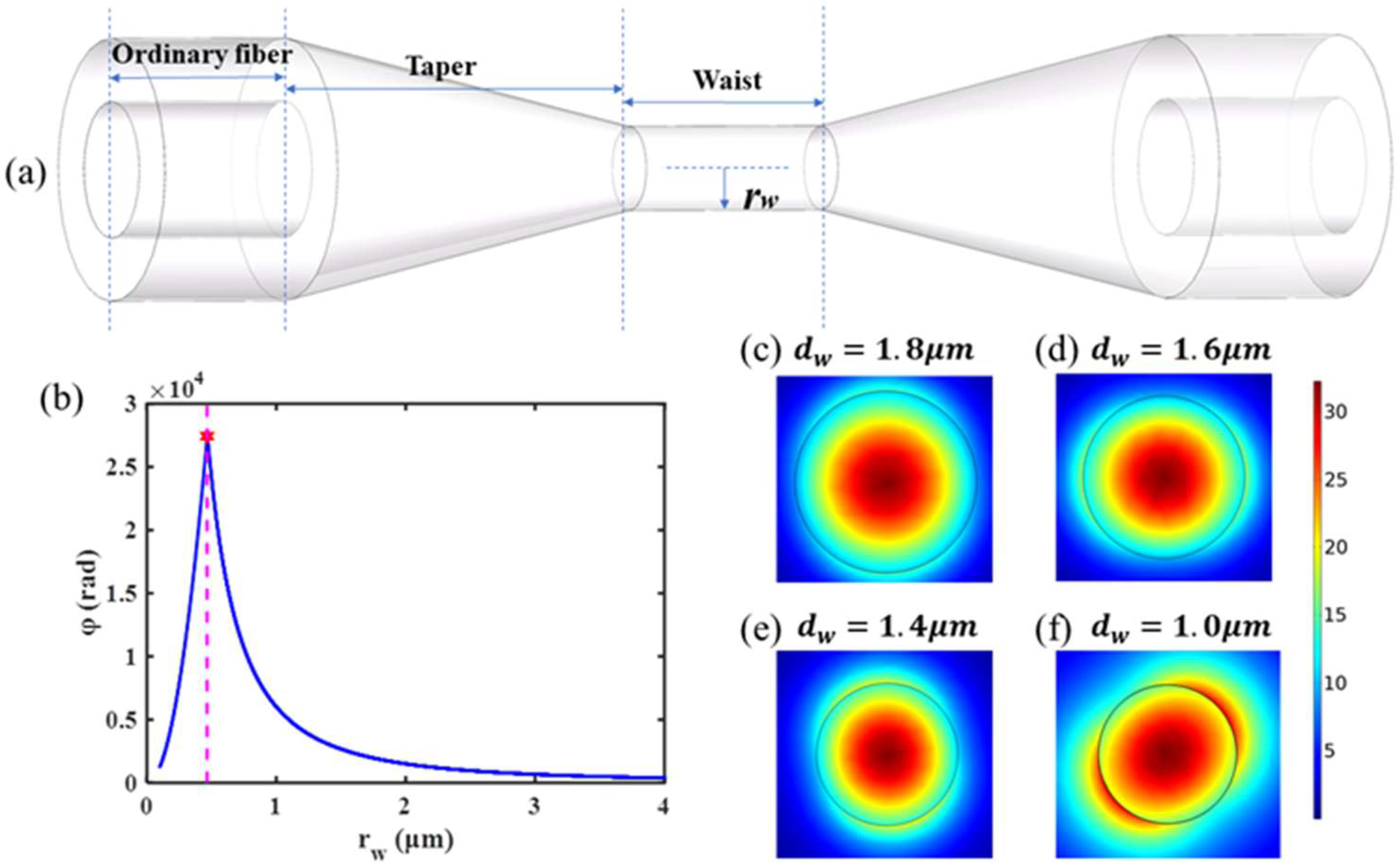

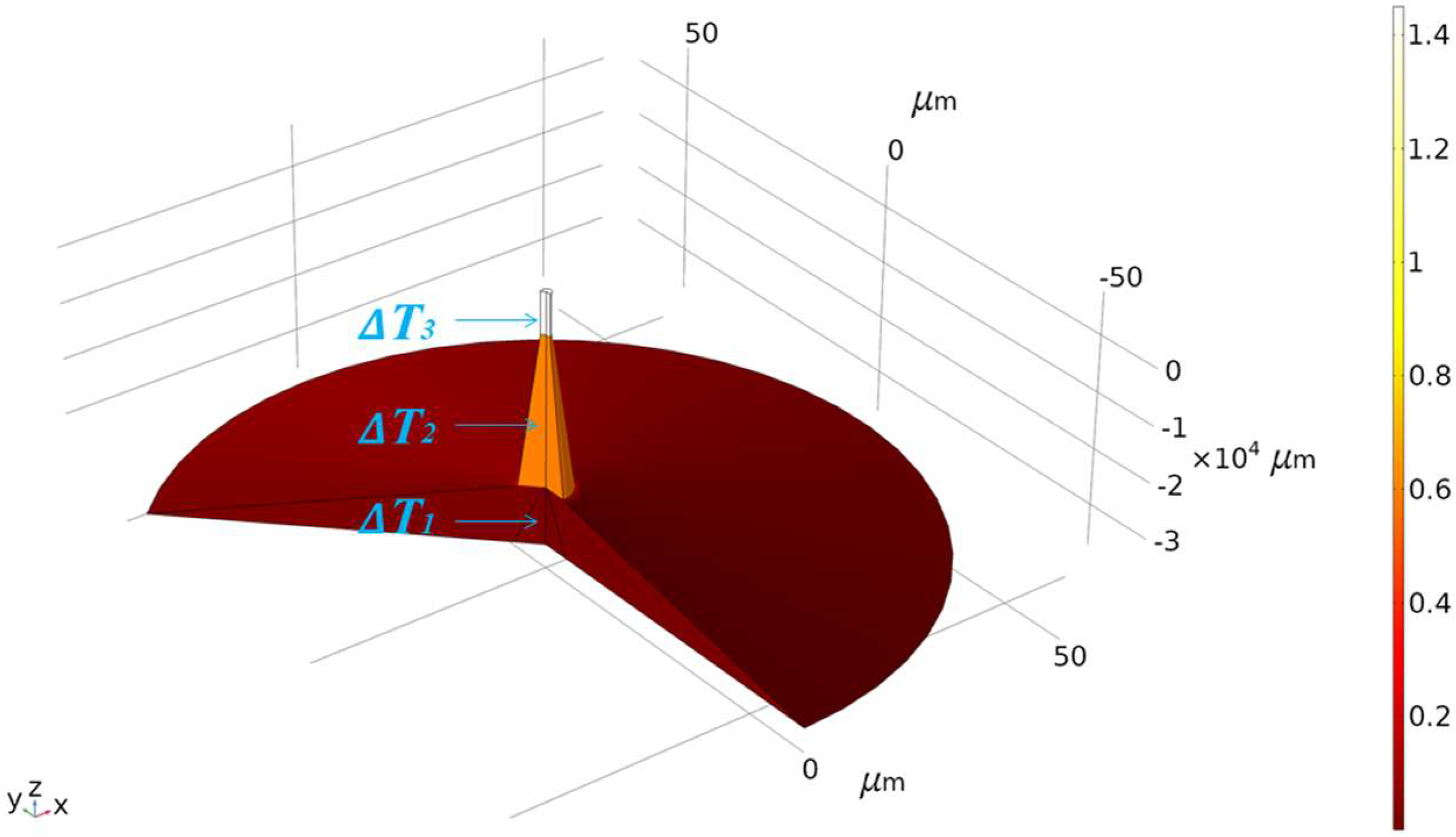
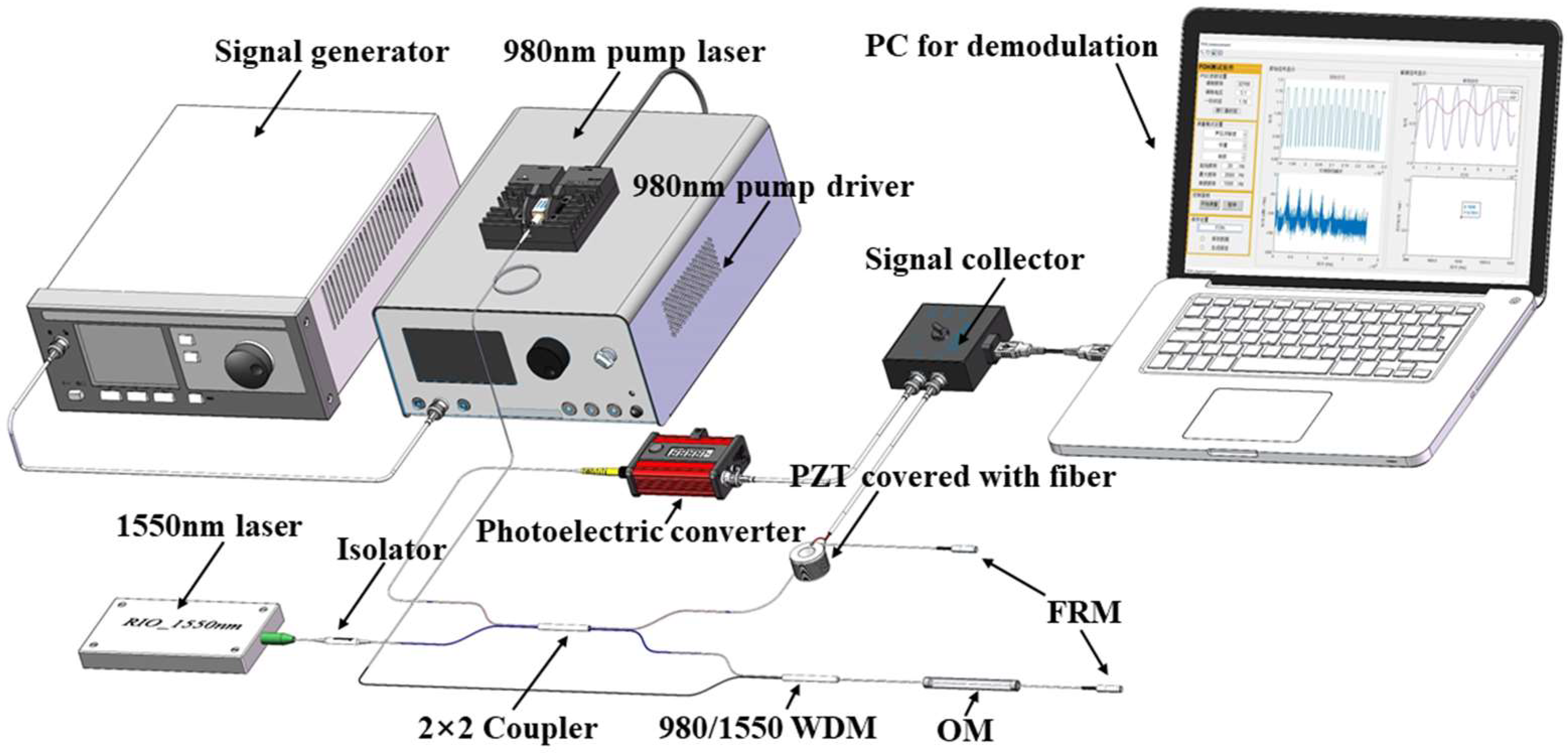
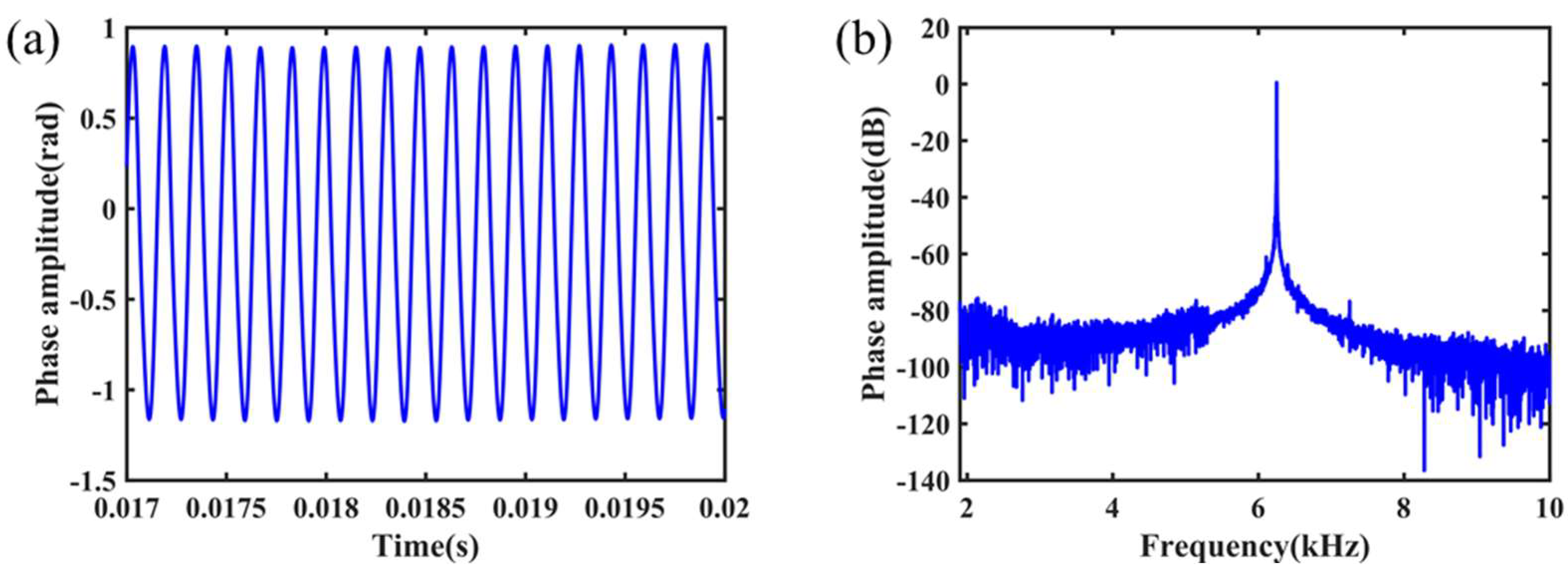


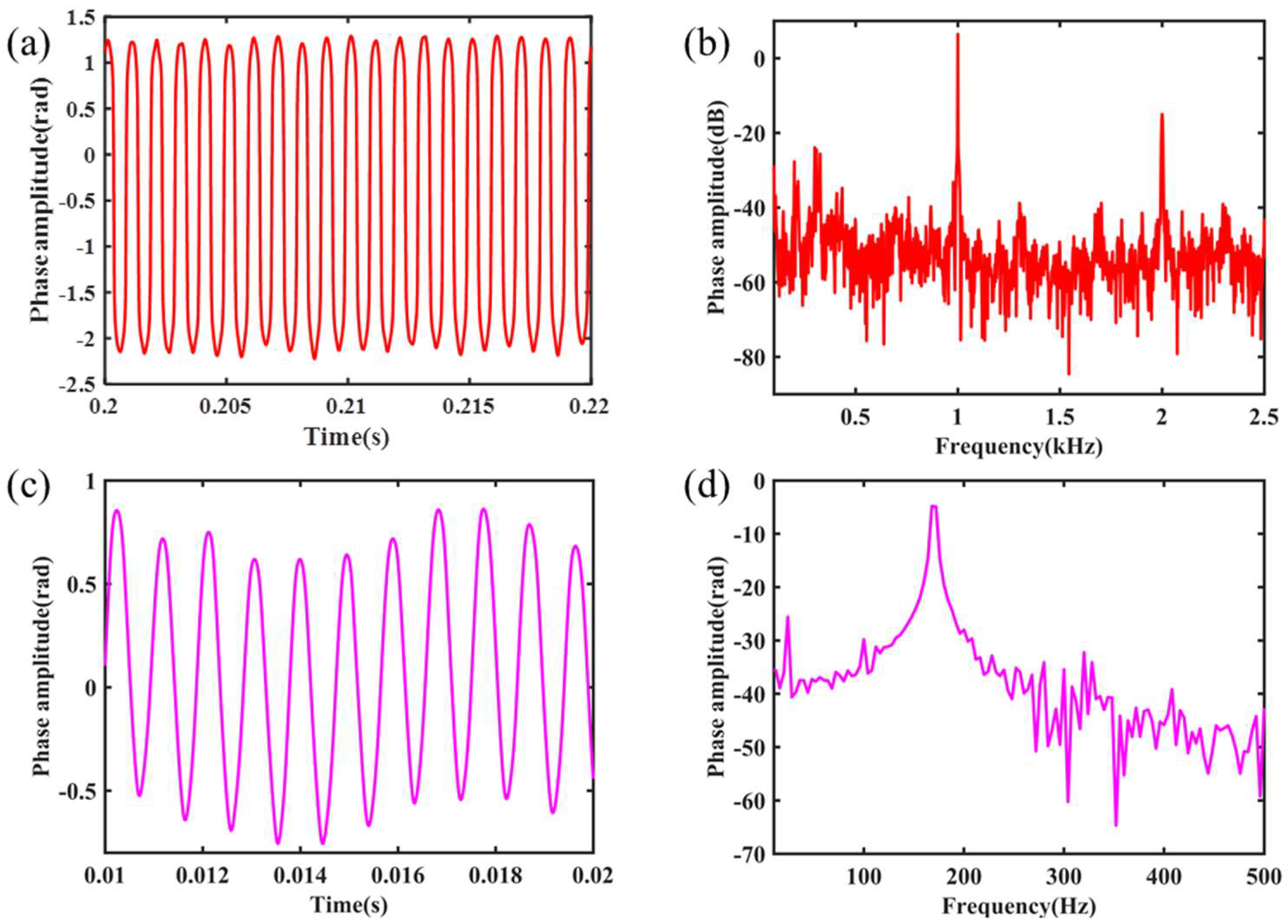
| Length of the Uniform Waist Area (mm) | Average Temperature Increase of the ‘Work Area’ (°C) | Average Temperature Decrease of the ‘Work Area’ (°C) | The Percentage of Decrease as Increase at ‘Work Area’ |
|---|---|---|---|
| 10 | 0.132 | 0.009 | 6.8% |
| 15 | 0.602 | 0.022 | 3.62% |
| 20 | 1.234 | 0.030 | 2.43% |
Publisher’s Note: MDPI stays neutral with regard to jurisdictional claims in published maps and institutional affiliations. |
© 2021 by the authors. Licensee MDPI, Basel, Switzerland. This article is an open access article distributed under the terms and conditions of the Creative Commons Attribution (CC BY) license (https://creativecommons.org/licenses/by/4.0/).
Share and Cite
Li, M.; Yu, Y.; Lu, Y.; Hu, X.; Wang, Y.; Qin, S.; Lu, J.; Yang, J.; Zhang, Z. Optical Microfiber All-Optical Phase Modulator for Fiber Optic Hydrophone. Nanomaterials 2021, 11, 2215. https://doi.org/10.3390/nano11092215
Li M, Yu Y, Lu Y, Hu X, Wang Y, Qin S, Lu J, Yang J, Zhang Z. Optical Microfiber All-Optical Phase Modulator for Fiber Optic Hydrophone. Nanomaterials. 2021; 11(9):2215. https://doi.org/10.3390/nano11092215
Chicago/Turabian StyleLi, Minwei, Yang Yu, Yang Lu, Xiaoyang Hu, Yaorong Wang, Shangpeng Qin, Junyang Lu, Junbo Yang, and Zhenrong Zhang. 2021. "Optical Microfiber All-Optical Phase Modulator for Fiber Optic Hydrophone" Nanomaterials 11, no. 9: 2215. https://doi.org/10.3390/nano11092215
APA StyleLi, M., Yu, Y., Lu, Y., Hu, X., Wang, Y., Qin, S., Lu, J., Yang, J., & Zhang, Z. (2021). Optical Microfiber All-Optical Phase Modulator for Fiber Optic Hydrophone. Nanomaterials, 11(9), 2215. https://doi.org/10.3390/nano11092215











